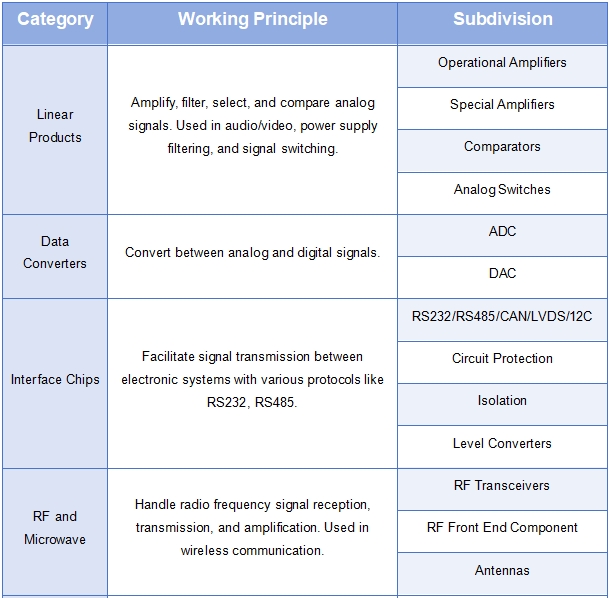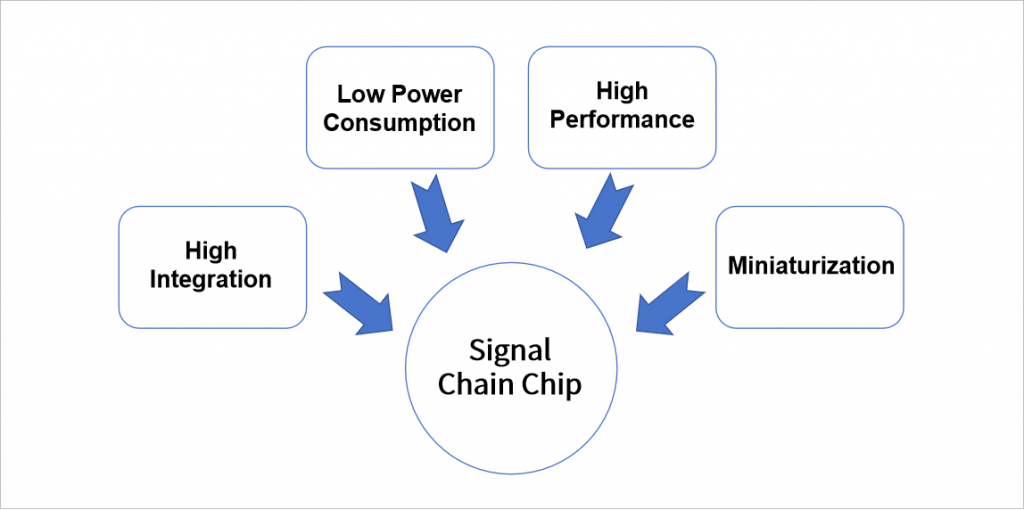Signal chain chips are an important part of analog chips, focusing on the conversion and processing of analog and digital signals. Their primary function is to convert analog signals (such as temperature, pressure, sound, etc.) into digital signals, or to convert digital signals into analog signals for further processing or output.
Signal chain chips are also known as linear chips, and the industry typically divides them into “RF signal chain chips” and “analog signal chain chips.”
Signal chain chips are core components in electronic systems, playing a crucial role in modern electronic systems. They not only connect the real world with the digital world but also play a key role in various fields such as communications, consumer electronics, industrial control, and medical devices.
Exhibit 1: Working Principle of Signal Chain Chips

The signal chain chip sector includes a variety of specialized integrated circuits, such as Analog-to-Digital Converters (ADCs), Digital-to-Analog Converters (DACs), amplifiers, filters, comparators, and interface chips. These components are carefully classified according to their functionalities and application areas to address the requirements of diverse electronic systems.
Exhibit 2: Working Principle of Signal Chain Chips

The signal chain chip industry is currently witnessing several pivotal development trends. Firstly, as technology progresses, there is an escalating demand for enhanced precision in signal chain chips, particularly within high-precision measurement and high-speed communication sectors. Secondly, the emphasis on low-power design has emerged as a critical factor for mobile and portable devices, propelling the advancement of low-power signal chain chips. Additionally, the movement towards integration is significantly influencing the signal chain chip market, as it minimizes the need for external components, thereby reducing system costs and spatial requirements through the consolidation of multiple functions. Moreover, in light of the exponential increase in data volume, the capability for high-speed processing has become a crucial focus for the evolution of signal chain chips. Finally, the trend towards intelligentization, which entails the incorporation of microprocessors or digital signal processors (DSPs) into signal chain chips to facilitate more sophisticated signal processing capabilities, is steadily establishing itself as a new industry standard.
Signal chain chips, acting as a bridge between the analog and digital worlds, are driving a leap in the performance of electronic devices with their technological advancements. In this critical field, several core characteristics stand out, determining not only the performance and application range of signal chain chips but also influencing the development trends of the entire industry. Here are the specific manifestations of these characteristics, which together outline the technological profile and market dynamics of the signal chain chip industry.
(1) Product Richness and High-end Development: With the increase in product richness, signal chain chips can address more complex application scenarios, and some products are gradually developing towards high-end, adding product value.
(2) Enhanced Performance Requirements: Technological development brings higher performance demands for signal chain chips, such as high-precision ADCs, low-power DACs, and high-integration transceivers, to meet the needs of complex applications.
(3) Size and Power Consumption Optimization: Signal chain chips are moving towards smaller sizes and lower power consumption to meet the market demands of mobile devices and portable electronic equipment.
(4) Functional Integration and System Simplification: By integrating various functional modules, signal chain chips reduce system complexity and enhance overall performance.
Exhibit 3: Development Directions of Signal Chain Chips
